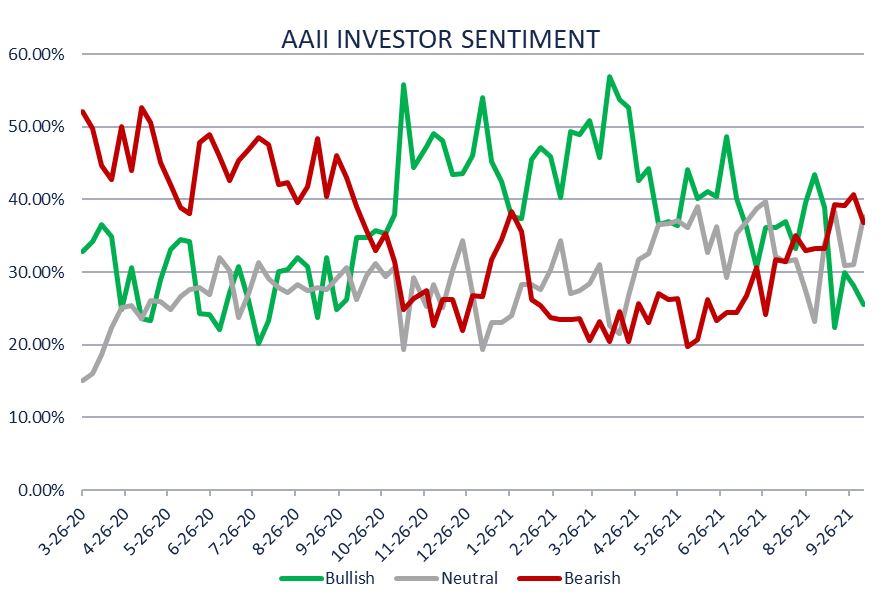What To Do About Market Volatility
October 13, 2021 •Nathan Willis

If you checked your investment balance at the end of the quarter, you may have noticed a pullback in your equity holdings. On September 30, the market dropped 5 percent from its all-time high. Volatility is a given in the stock market. The key to long-term success is long-term investing. However, this is the largest dip in 2021, so we wanted to address a few key matters as we begin the fourth quarter.
This volatility is expected. While it is impossible to predict market pricing perfectly, we have maintained for over a year that equity valuations are stretched compared to their own histories. High valuations make stocks susceptible to pullbacks. Simply put, stocks have been expensive for a long time, and it’s natural for the market to correct.
This volatility has specific drivers. Though a dip was bound to happen, four specific factors have contributed to the recent market drawdown. (There are always forces that could cause a pullback in your portfolio; if it weren’t these four, it would be another four. But these are the important ones for right now.)
- Budget and international relations uncertainty in Washington. To avoid the government depleting all of its cash reserves by late October, Congress suspended the debt ceiling question until December. The White House’s initial outlay of a Chinese trade strategy assuaged few concerns of international corporations.
- Real estate risk in China. Evergrande is a Chinese property developer that owes over $300 billion to investors, employees, and suppliers, and it may not be able to pay. On October 5, another Chinese developer failed to repay a $206 million bond. It is unclear if or how Beijing may address overleveraged property companies. Though a collapse is not eminent, defaults could ripple throughout international markets. What we are seeing now is in part a reaction to this uncertainty.
- Controversies at Facebook. The Wall Street Journal has reported a flurry of internal flaws with Facebook’s impact on society. Algorithm changes made the platform a more hostile place, the company responded inadequately to human trafficking and drug cartels operating on the site, and select users are exempt from the content standards rules that ‘apply to all.’ Perhaps most importantly, internal documents demonstrate Instagram’s toxic impact on teenage girls, though the company’s historic narrative has been the opposite. These controversies mirror a tech tumble in the market experienced by Google and Amazon.
- Fed signals for tapering. Jerome Powell said the central bank may scale back bond purchases this quarter, finishing the process mid-2022. This is presumably in preparation for a gradual interest rate increase projected to begin in mid-2023. As a result, longer-term yields are increasing relative to short-term, which can lead to market volatility.

This volatility is not without positives. The number of bullish investors has dipped below bearish investors. This is a contrarian indicator, meaning when investors think the market is headed in a negative direction over the next six months, it just might be time to invest. Warren Buffett popularized this mentality, saying it’s wise to take risk when others are fearful.

This volatility is normal. We invest in the stock market to capture long-term returns. Safe landings that are right on time and right where you want to be require taking turbulence in stride. Remember your goals, stay focused, and talk with your advisor to make sure you’re on track.
Past performance may not be indicative of future results. Therefore, no current or prospective client should assume that the future performance of any specific investment, investment strategy (including the investments and/or investment strategies recommended by the adviser), will be profitable or equal to past performance levels.
This material is intended to be educational in nature, and not as a recommendation of any particular strategy, approach, product or concept for any particular advisor or client. These materials are not intended as any form of substitute for individualized investment advice. The discussion is general in nature, and therefore not intended to recommend or endorse any asset class, security, or technical aspect of any security for the purpose of allowing a reader to use the approach on their own. Before participating in any investment program or making any investment, clients as well as all other readers are encouraged to consult with their own professional advisers, including investment advisers and tax advisors. OneAscent can assist in determining a suitable investment approach for a given individual, which may or may not closely resemble the strategies outlined herein.
Any charts, graphs, or visual aids presented herein are intended to demonstrate concepts more fully discussed in the text of this brochure, and which cannot be fully explained without the assistance of a professional from OneAscent. Readers should not in any way interpret these visual aids as a device with which to ascertain investment decisions or an investment approach. Only your professional adviser should interpret this information.
OAFS772


